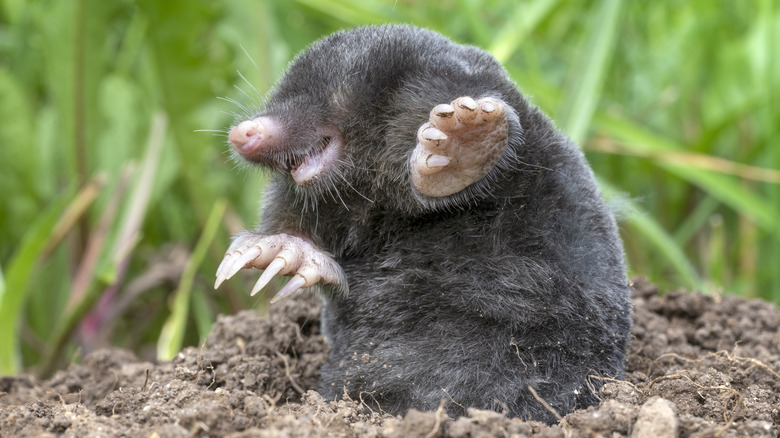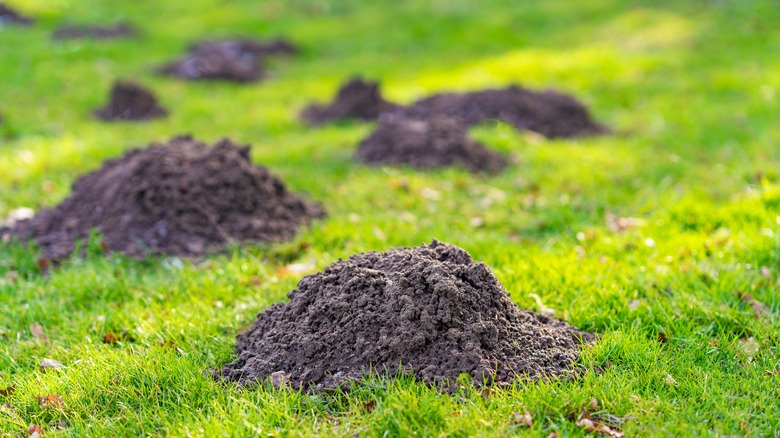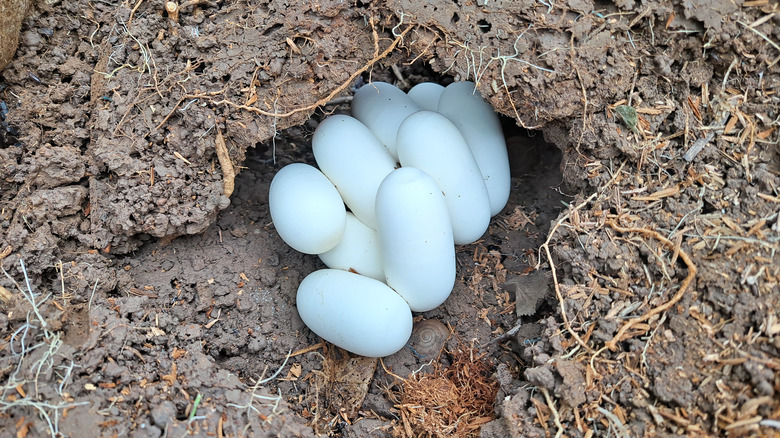Mole Vs Snake Hole: How To Tell Which Is In Your Yard
Taking a walk through your yard and appreciating the scenery is one of the quiet luxuries we get to enjoy as homeowners. However, that little slice of serenity can quickly evaporate when you spot some suspicious-looking holes in the ground. Snakes are notorious for dwelling in holes, usually abandoned ones built by other creatures, but they're not the only animals that live in crevices. Ground moles also live in underground burrows that surface as holes in the ground. If you're burdened with having to tell them apart to know which intruder you're housing, the biggest indicator is if there is a two-to-three-inch mound on it. Mounds mean the hole was dug and snakes don't dig — moles do.
Moles are excellent diggers and regularly dig rows of burrows under the ground. This means that the sight of fresh mounds with no conspicuous hole likely means it's a mole hole. While some snakes can wriggle into well-aerated soil to create a hole decent enough to live in, they don't dig up soil for an obvious reason: they don't have claws.
This is just one of several ways you can differentiate between a snake and a mole hole, but you can never be truly sure unless you actually see the animal in the hole or identify some of its droppings or young. You have to be acquainted with the regular behavioral patterns of each of the animals to infer who your special housemate is and take the proper action against them.
Moles disturb the vegetation nearby while snakes do not
Because snakes don't dig up dirt and usually either steal another animal's hole or shrug into loose dirt to make a small one, their holes are more like crevices. You can see the opening and it can go inches deep, but that's where it ends. As for moles? They live to dig tunnels, so their holes would naturally have various tunnels running underneath which often causes the surrounding soil to collapse within. This is another indicator that you have moles instead of snakes. Snake holes are usually in plain sight.
Another factor of differentiation between mole and snake holes, which will signal to you which one is occupying your yard, is how the surrounding vegetation looks. Snakes don't disturb the area, but moles dig up roots and destroy gardens and lawns with their burrowing activity. They leave a trail of destruction in their wake. Because snakes use their slender bodies to form precise holes for themselves, their holes usually take on that slim, narrow shape. Mole holes, on the other hand, tend to be more oval-shaped.
Climate plays an important role in figuring out which animal lives in the hole in your yard. Garden snakes usually prefer to live in warmer climates because they are cold-blooded and depend on the sun's heat to warm themselves. Moles don't mind cooler weather. If you live in either of these regions, that could help you pinpoint the animal culprit.
Check for signs of animal activity near the hole
You can't know for sure what animal is living in the hole in your yard because, while moles build their own holes, a snake could've moved into an abandoned mole hole. Snakes shed their skin and this is common knowledge. The presence of shed skin around the hole is an almost foolproof method of identifying the occupying animal as a snake. Snakes also lay eggs so if you're able to peep into the hole and find some eggs, it's a tell-tale sign you have a snake hole in your yard.
Moles' digging activities leave raised rows of dirt along the path of their underground tunnels. If you find these kinds of ridges in your lawn day after day, it's most likely a mole infestation you need to get rid of. Because these rodents rarely come up to the surface of the ground, they are almost impossible to see. If you suspect you have a mole infestation, you have to contact a professional exterminator right away as their burrows can threaten the quality and life of your property. Snakes are a lot less pervasive, but if you live in an area with venomous snakes, you probably don't want them on your property, either.


